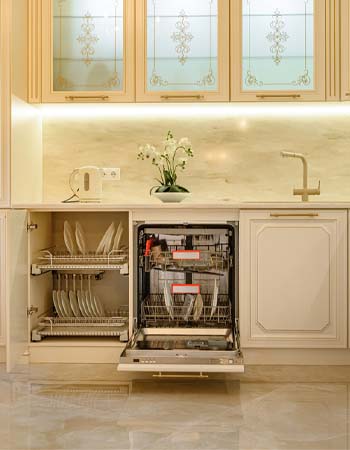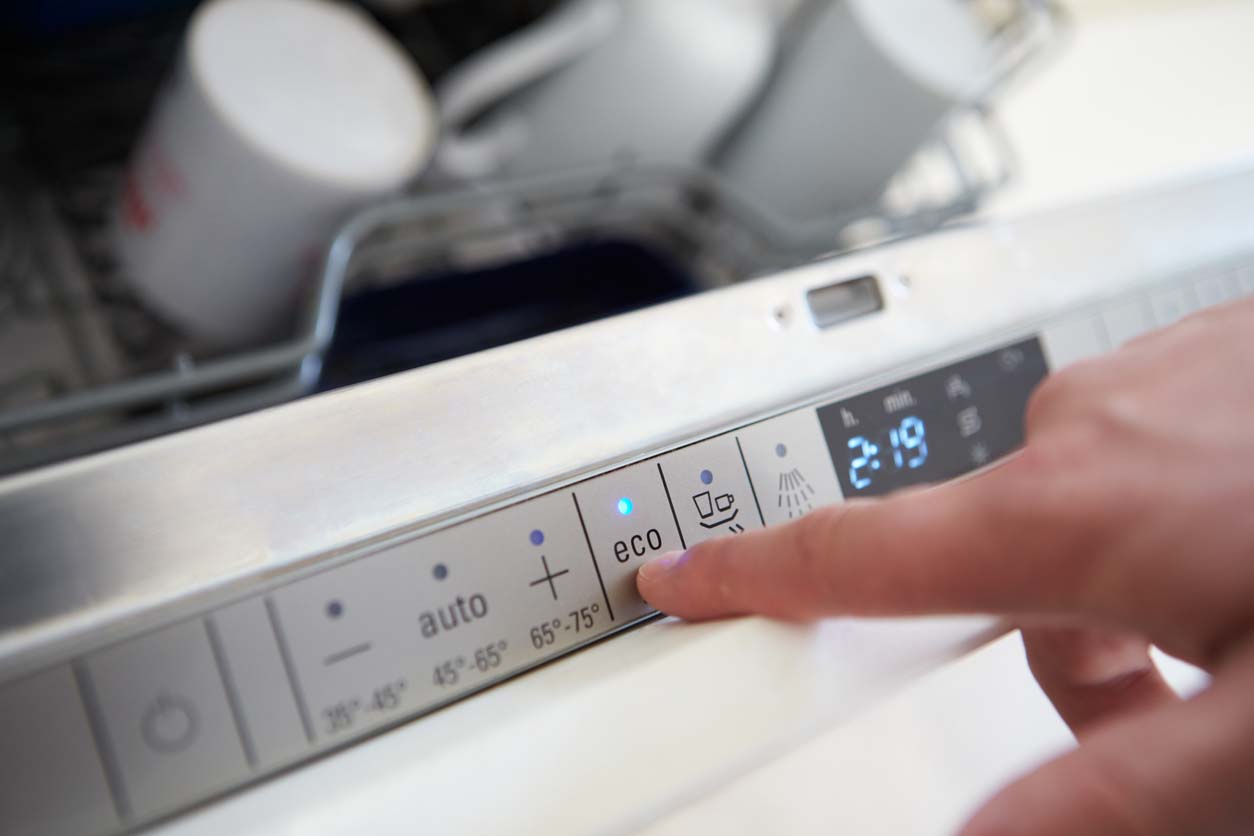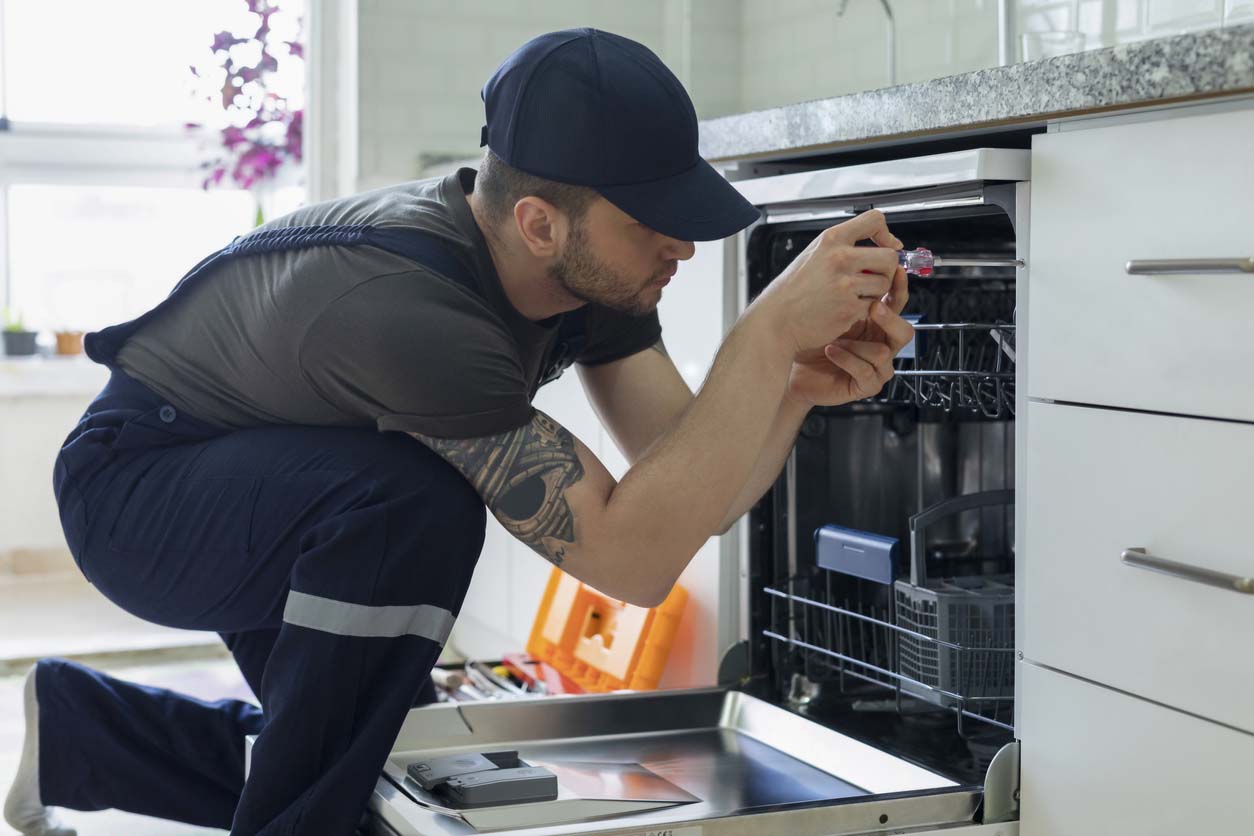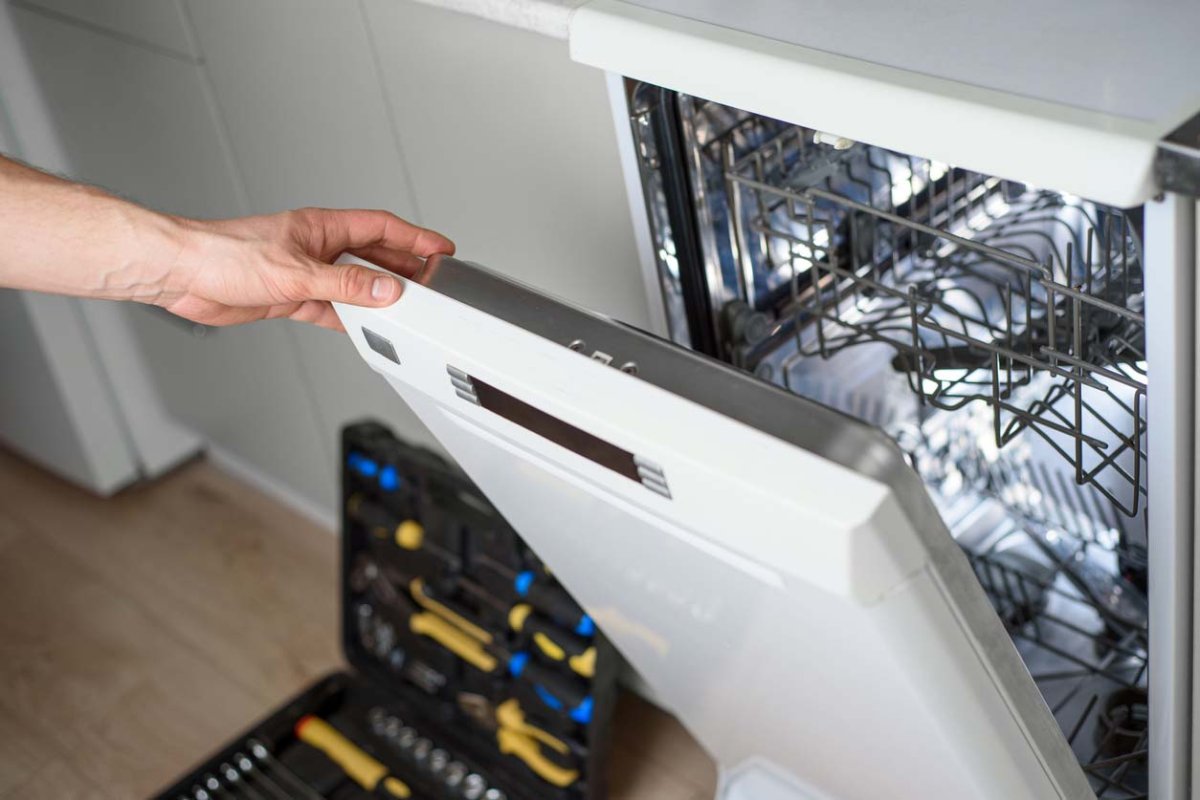We may earn revenue from the products available on this page and participate in affiliate programs. Learn More ›
Q: I just loaded the dishwasher, turned it on, and nothing happened. I double-checked to make sure the door was latched securely, but it still wouldn’t start. What should I do when my dishwasher won’t turn on? Is there anything I can do, or should I call a plumber?
A: There can be several reasons a dishwasher is experiencing this problem. Common difficulties homeowners have with dishwashers are issues with a machine not getting water, not draining properly, or not starting at all. When your dishwasher won’t turn on, there are a few troubleshooting tips you can attempt before you call in a professional.
Make sure the dishwasher is plugged in and there is no child-lock feature engaged.

Ensure the dishwasher is plugged into an outlet and the plug hasn’t come loose. On occasion, dishwashers can come unplugged due to the machine’s vibrations, a garbage disposal, or other nearby kitchen appliances. This will usually require you to pull the dishwasher out from under the counter and away from the wall. If it’s properly plugged into the outlet, there could be a possibility that a fuse blew inside the plug. To check, plug in a small appliance (like a toaster or blender) to see if it will turn on. If so, check the circuit breaker box to see if a breaker has been tripped. To reset a breaker, flip it to the “off” position, then back to the “on” position.
Some dishwashers have a child-lock feature that prevents an accidental start or changes to the wash cycle. Or, if a delayed-start feature has been accidentally selected, it can prevent the dishwasher from turning on when the start button is pushed. It’s recommended to refer to the owner’s manual for instructions on correctly disabling the child lock or delayed-start features.
Try resetting the dishwasher.
If the dishwasher won’t start but has power, it could be stuck between cycles. If the start button has been pushed more than once, the dishwasher may revert to a drain cycle. To remedy this, allow the drain cycle to run, let it sit for 60 to 90 seconds, then press the start button once. If you notice that the buttons are illuminated or flashing, unplugging the machine for a minute or two and then plugging it back in can help reset the dishwasher. Some machines may have a reset button or require a specific procedure to reset. You will want to check the owner’s manual for the manufacturer’s instructions regarding a reset for a dishwasher that has power but won’t turn on.
Check the door latch to make sure it’s working properly.
If the dishwasher will not turn on, check the door latch. If the door isn’t closing properly, the door latch or switches may be to blame. The door-latch assembly not only keeps the door tightly closed to prevent leaks, but it signals the control panel that it’s time to begin a wash cycle. If the door cannot close properly to activate the switches, the dishwasher won’t be able to start. Inspecting the latch for visible signs of damage or checking the switches with a multimeter can pinpoint a problem. To test the dishwasher latch and switches:
- Disconnect the machine from its power source.
- Remove the door panel to find the latch and switches located at the top of the door.
- Double-check to see if the latch activates the switches when it’s inserted.
- Remove the switches and check them with a multimeter on Rx1. Touch the meter’s probes to the switch terminals and check the reading. If it’s at zero or near zero, the switches are fine. If the reading displays another result, the door latch assembly will need to be replaced.
The selector switch could be stuck between settings.
The selector switch on a dishwasher is used to change the machine settings. When a dishwasher doesn’t turn on, the switch may be defective or broken or the connections may be damaged. Before taking anything apart, check the control panel and push the selector switch to ensure it’s not stuck between wash settings. Once it’s properly depressed, you can remove the switch and test it with a multimeter on Rx1.
- Disconnect the machine from its power source.
- Touch the probes to the switch terminals. Each button needs to be tested separately and should display a reading of infinity.
- With the probes still touching the terminals, press the button of the corresponding terminal. This should display a reading of zero.
- Repeat these steps for each button.
- If your readings do not match and the dishwasher doesn’t turn on, the selector switch will need to be replaced.

You can check the timer, electronic control, motor start relay, and thermal fuse.
If the door-latch assembly and the selector switch are working properly, there are a few additional parts to test to see if they’re the cause of the problem. Be sure to disconnect the machine from its power source before attempting these steps.
The dishwasher timer sets the start and end times for the wash cycles. The timer is typically located in the control panel, but sometimes it’s found in the lower kickplate. It’s important to refer to the wiring diagram in the owner’s manual to find which contacts to test. With the multimeter set at Rx1000, touch the probes to the contacts. The owner’s manual will contain information regarding the expected reading, but many models will be within the range of 2,000 to 3,500 ohms of resistance. If the results are different from the manual’s, the timer should be replaced.
A motor start relay supplies power to the motor and signals it to start. Usually located next to the pump in the lower access panel, the motor start relay needs to be removed to be tested. Refer to the wiring diagram in the owner’s manual, set the multimeter to Rx1, and test the coil. It should display a reading of zero or near zero. The next step is to turn the start relay upside down so the plunger drops. Once that happens, touch the probes to the relay terminals. This should also produce a reading of zero or near zero. If not, the motor start delay should be replaced.
A dishwasher’s thermal fuse protects the machine from overheating. If the fuse is broken, the dishwasher may not turn on. To test it, access the control panel and find the two wires that connect the fuse to the control panel. These wires need to be disconnected before removing the fuse. Set the multimeter to Rx1 and touch the probes to the contacts. The reading should be zero or near zero; if not, that’s a sign to replace the thermal fuse.
The drive motor may be defective.
If the drive motor isn’t working, the dishwasher may not start. The drive motor is found behind the lower access panel. You’ll want to disconnect the wires from the drive motor and remove it for testing. With the multimeter set at Rx1, touch the probes to the terminals and expect a reading of zero or near zero. Next, touch one of the probes to the motor’s metal housing. This shouldn’t produce a reading, but if your results are different, it’s time for a new drive motor.

Consider hiring a professional appliance repair technician who’s familiar with your dishwasher brand.
If you’ve tried all of these troubleshooting steps (or if finagling with an appliance’s inner workings is not your forte), it’s time to call in a pro. A professional appliance repair technician can assess the problem and determine if it can be fixed or if it’s time for a new dishwasher. Small repairs will probably be completed on the day of the appointment, but more extensive repairs may take some additional time if parts need to be ordered and delivered. It might also be worthwhile to look into a policy from one of the best home warranty companies (such as American Home Shield or AFC Home Club). This can help alleviate repair costs in the long term.


